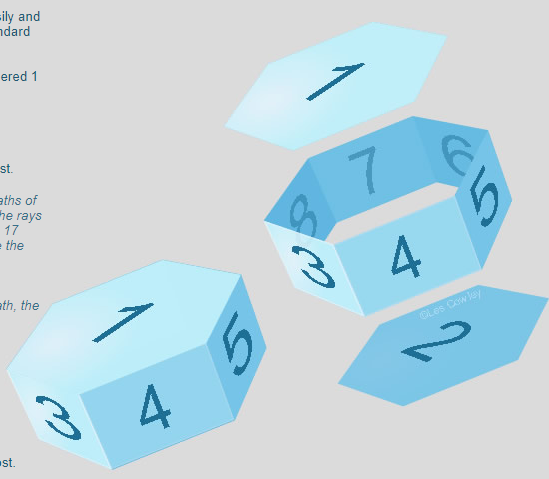Crystal face numbers
Crystal Face Numbers: Understanding the Intricacies of Atmospheric Optics
Atmospheric optics is a fascinating field that explores the optical phenomena occurring in our atmosphere. One important aspect of atmospheric optics is the study of crystal face numbers. Crystal faces play a crucial role in determining the paths of light rays and the formation of various optical phenomena such as halos, arcs, and sundogs. In this article, we will delve deeper into the topic of crystal face numbers and their significance in understanding the intricacies of atmospheric optics.
Understanding Crystal Face Numbering Scheme
To describe halo ray paths accurately, crystal faces are assigned standard numbers. By following a consistent numbering scheme, we can precisely analyze and interpret the behavior of light rays as they interact with different crystal faces. Let's explore some key aspects of crystal face numbering:
-
Basal (end) faces: These faces are always numbered 1 and 2. They serve as reference points for understanding the orientation of other crystal faces.
-
Prism side faces: The prism side faces are numbered from 3 to 8. These faces are responsible for the refraction and reflection of light, leading to the formation of various optical phenomena.
-
Plate crystals: In plate crystals, face 1 is always positioned at the uppermost part of the crystal. This orientation has implications for the formation and appearance of specific optical phenomena.
Unraveling the Paths of Light Rays
Crystal face numbers provide valuable insights into the paths followed by light rays as they pass through different types of crystals. Let's explore some specific examples:
-
Circumzenithal Arc: The ray paths for a circumzenithal arc are described by the sequence of faces 13, 14, 15, 16, 17, and 18. However, it is important to note that paths 14 to 18 are essentially the same as path 13. Therefore, it is customary to refer to the path using the lowest number equivalent face, which in this case is 13.
-
Sundogs: The left-hand sundog follows a path described by face 35, while the right-hand sundog corresponds to face 37. These paths provide valuable information about the orientation and interaction of light rays with specific crystal faces.
-
Column Oriented Crystals: The behavior of light rays passing through column-oriented crystals is influenced by their unique orientation. Understanding the crystal face numbers in these crystals helps us unravel the complex paths of light rays and the resulting optical phenomena.
-
Tangent Arc: A tangent arc is formed when light rays pass through specific crystal faces, namely face 35. This phenomenon is characterized by its distinct arc shape and provides researchers with valuable insights into the behavior of light in the atmosphere.
-
Supralateral Arc: The supralateral arc is another fascinating optical phenomenon that occurs due to the interaction of light rays with crystal faces. It is formed by rays passing through face 31, and its appearance and characteristics are influenced by the properties of this particular face.
Crystal Face Orientation and Optical Phenomena
The orientation of crystal faces plays a significant role in determining the appearance and characteristics of various optical phenomena. Let's explore two specific examples:
-
Parry Crystals: Parry crystals have face 3 positioned at the uppermost part of the crystal. This unique orientation influences the formation of halos and other optical phenomena associated with these crystals.
-
Lowitz Oriented Crystals: In Lowitz oriented crystals, the Lowitz axis passes through the edges between faces 4 and 5. This orientation affects the behavior of light rays and contributes to the formation of distinct optical phenomena.
Understanding the orientation and numbering scheme of crystal faces allows researchers and enthusiasts to analyze and interpret atmospheric optical phenomena with greater precision. By studying the intricate interplay between light rays and crystal faces, we can unlock the secrets of the mesmerizing world of atmospheric optics.
In conclusion, crystal face numbers are a fundamental aspect of atmospheric optics. They provide a standardized framework for describing and understanding the paths of light rays as they interact with different crystal faces. By unraveling the complexities of crystal face numbers, we gain valuable insights into the formation and characteristics of various optical phenomena. So, the next time you witness a halo, arc, or sundog in the sky, remember that the arrangement of crystal faces is responsible for these captivating displays of light in our atmosphere.

We can describe halo ray paths easily and precisely if crystal faces have a standard numbering scheme.
Basal (end) faces are always numbered 1 and 2.
Prism side faces are 3 to 8.
Plate crystals have face 1 uppermost.
A circumzenithal arc has ray paths of 13. This is sequence of faces the rays pass through. Paths 14,15, 16, 17 and 18 are the same, we quote the path with the lowest number equivalent face.
A left hand sundog has a 35 path, the right hand is 37.
Column oriented crystals
A tangent arc is 35.
A supralateral arc is 31.
Parry crystals have face 3 uppermost.
Lowitz oriented crystals have the Lowitz axis passing through the edges between faces 4 and 5.
Note: this article has been automatically converted from the old site and may not appear as intended. You can find the original article here.
Reference Atmospheric Optics
If you use any of the definitions, information, or data presented on Atmospheric Optics, please copy the link or reference below to properly credit us as the reference source. Thank you!
-
<a href="https://atoptics.co.uk/blog/crystal-face-numbers/">Crystal face numbers</a>
-
"Crystal face numbers". Atmospheric Optics. Accessed on November 23, 2024. https://atoptics.co.uk/blog/crystal-face-numbers/.
-
"Crystal face numbers". Atmospheric Optics, https://atoptics.co.uk/blog/crystal-face-numbers/. Accessed 23 November, 2024
-
Crystal face numbers. Atmospheric Optics. Retrieved from https://atoptics.co.uk/blog/crystal-face-numbers/.